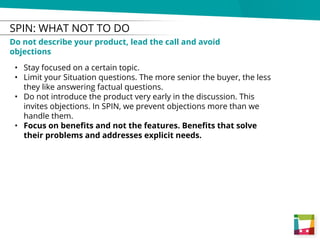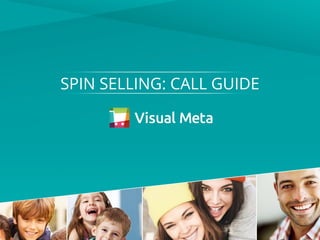Spin selling training
- 1. SPIN SELLING
- 2. SPIN: BEST CONSULTATIVE SELLING The most tested sales questioning technique • Based on massive research conducted on over 35,000 sales calls • Initial companies were Xerox and IBM • 17% increase on sales after their SPIN Selling implementation • 90% of Fortune 500 companies follow this model for their sales force What is SPIN exactly? ● A method for salespeople to ask a potential buyer questions in order to expose their problems and then develop a tailored solution
- 3. VISUAL-META & SPIN SELLING Sales environment has evolved over the years, adapt yourself • Customers understanding of the product vs. their problems were understood • People buy when the pain of the problem is greater than the cost of the solution • The opening: gain the buyer's agreement to ask questions, to establish a buyer-centered purpose and communicate who you are and why you are there • Customers will only be motivated to buy something if they identify there’s a need
- 5. SITUATION QUESTIONS Seek for information that will help you understand your customer´s context Definition Finding out facts about the buyer's current situation. Examples Are you getting enough clicks to generate your targeted revenue? Are you satisfied with the current conversion rate? Impact Finding a specific piece of information for data gathering. Advice Do not ask too many of them, they will just bore the prospect. Do research in advance of the conversation. The more Situation questions in a call, the less likelihood of success. Ask Situation questions economically.
- 6. PROBLEM QUESTIONS Definition Finding about problems, difficulties and dissatisfaction. Examples How does a less satisfactory conversion rate affect your business? Do you foresee challenges associated with your vision this year? Why is it such a big challenge for you? Impact More powerful than Situation questions. Most people ask more Problem questions as they become more experienced. Advice Think of your products and services in terms of problems they solve, not details or characteristics. Follow-up with questions that ask more detail about the problem. Uncover opportunities and your prospect's pain
- 7. IMPLICATION QUESTIONS Definition Asking about the consequences or effects. Implication Questions discuss the effects of the problem, and develop the seriousness of the problem to increase the buyer's motivation to change. Examples Does the current visibility issues affect the profitability of the platform? What's the worst thing that can happen if the vision is not met because of these challenges? With low visibility, I assume that it affects the profitability as well? Impact These are the most powerful of all the questions, because they help the buyer see that the problem is big enough to justify the cost, they induce and build pain Advice Always make sure that you link your Implication questions to other parts of the conversation, in that way you will communicate your expertise and the client will know that you understand their world view. Explore the implied needs, a clear statement of a buyer's problem. Explore problems and outline consequences, help the customer to feel the urgency
- 8. NEED-PAYOFF QUESTIONS The problem can finally be solved Definition Value or usefulness of a solution. Need-Payoff questions get the buyer to tell you about their explicit needs and the benefits your solutions offers. Examples How do you think a higher number of quality visitors will benefit your online shop? If we could help channel qualified traffic to your site, how would that help you? Impact Positive impact creates the right condition for selling. Advice Use these to get the buyers to tell you the benefits. Explore the explicit needs, a clear statement of a buyer's desire or intention to act.
- 9. SPIN MINDSET Build a rapport with the buyer, understand his needs and propose a solution • It’s more important to understand than to persuade • Seek first to understand then to be understood • People do not buy from salespeople because they understand their products but because they felt the salesperson understood their problems. Do not describe your product, sell a solution to the buyer´s problem. • Effective Planning takes you more than halfway to effective execution. • Top Sales People tended to introduce solutions, products or services very late in the discussion. They held back and discussed the effects of the problem before talking about solutions. • SPIN Selling will help you out to work your sales funnel • People buy when the pain of the problem is greater than the cost of the solution.
- 10. SPIN: WHAT NOT TO DO Do not describe your product, lead the call and avoid objections • Stay focused on a certain topic. • Limit your Situation questions. The more senior the buyer, the less they like answering factual questions. • Do not introduce the product very early in the discussion. This invites objections. In SPIN, we prevent objections more than we handle them. • Focus on benefits and not the features. Benefits that solve their problems and addresses explicit needs.
- 11. SPIN Selling Animated SPIN Selling in other words
- 12. SPIN SELLING: CALL GUIDE
- 13. PARTS OF THE CALL GUIDE Opening: • This is critical as it dictates the pace of the whole call. • First impression • Rapport building • A good introduction opens up a favorable situation for SPIN Selling. Qualification: • Qualification – Know that you are speaking to the person who can make things happen for you. • Macro – Give a hint on how the company helps the biggest partners • Micro – Presentation of problems that our product solves. It bridges the call to the SPIN process.
- 14. PARTS OF THE CALL GUIDE SPIN • 20% - Seller, 80% - Customer • Ask as little Situation Questions as possible • Focus on Problems and Implications • It increases the value of the product • Lead the call, be the one doing the questions to avoid objections Recap and Test of Value • 95% - Seller, 5% - Customer • Let the customer know that you are listening. • Test if the customer sees value in a solution. • Bridges the SPIN to selling.
- 15. PARTS OF THE CALL GUIDE VLM – Value Led Matching (Selling!!!) • 90% - Seller, 10% - Customer • Take advantage of the value that was built during the SPIN process. • Explain the product’s features and benefits and how it will solve their issues so the implications can be avoided. Closing Time!!! • 90% - Seller, 10% - Customer • Pre-emptive urgency – to close the sale earlier • Decision Making Process • Decision Making Unit
- 16. THE ACTUAL CALL GUIDE https://docs.google.com/document/d/1fRIEMA8MTiKACxu1x7tFs6qSw tjR_t-yMcGR9Mno36k/edit

















